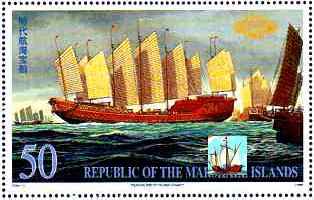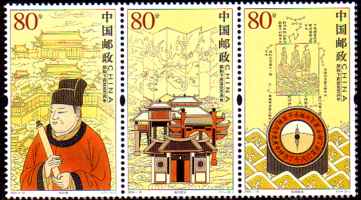|
Maritime Topics On Stamps:

|
Admiral Zheng He,
the Columbus from the Far East !
|

|
600 years ago the first long voyage of the Chinese admiral Zheng He began.
|
Between 1405 and 1431 he conducted seven voyages to the Pacific, to the Indian
ocean and to the Persian Gulf. It is supposed that he also reached America.
Celebrating these voyages a lot of different stamps regarding Zheng He and his
armada were issued.
|
|
Zheng He was born in the year 1371 in a town called Jinning today - in Yunnan
province of China. At birth he was called Ma Sanbao and was raised as a muslim.
In 1382 an army of the Ming dynasty conquered Yunnan and Zheng He was
imprisoned at the age of eleven. Three years later, in 1385, he was selected
for service at the court of the emperor and therefore castrated.
|

| |
He worked in the house of the prince Zhu Di, where he soon acquired his trust.
Zheng He helped the prince in a three-year-long, bloody succession war. After
his heroic deeds in the battle of Zhengluba in the vicinity of Bejing he was
named Zheng He. In 1402 Zhu Di became the 3rd emperor of the Ming dynasty and
Zheng He was already his closest advisor.
|

|

|
The emperor called his epoch Yongle, (translated "eternal joy") and was very
ambitious to live up to his plans. First of all he ordered Zheng He to build an
enormous fleet. Between 1404 and 1407 1,681 ships were built or overhauled.
Shipbuilding, navigation and maritime trade prospered.
The size of this armada seemed so improbable to most researchers that many
dismissed it as myth. Nevertheless more and more remnants of these ships were
actually discovered which confirmed the numbers.
According to Chinese sources Zheng He commanded 70 fleets with 300 ships or
more and a 30,000 strong crew.
In 1405, on his first journey, the fleet consisted of 317 ships. Among them
were the legendary treasure ships, the Fuchan warships, patrol boats, horse
ships, supply ships, troop transporters and water tankers.
|

|
|
These huge junks were called treasure ships because they were as valuable as a
treasure. Some data: Length 467 to 537 feet, beam around 180 feet, loading
capacity 3,600 tons with 1,600 tons ballast. They contained 16 waterproof
bulkheads made from bamboo, who could be flooded during a storm to gain
additional ballast for stability reasons - an innovation, long before the
Europeans discovered it. The trunk had three layers of planks made from teak
and bamboo. The junks had 7 to 10 masts with lug sails and top sails, which
were strengthened with continuous bamboo battens.
|

|

| |
The armament consisted of 24 bronze cannons with crosshairs, flame throwers,
catapults for grenades and "crossbow machine guns", which could fire up to 20
arrows in 15 seconds. They also carried naval mines called "underground
thunder ascending to the sky". Gun powder is a Chinese invention.
|
All sails were allegedly made from blood-red silk, the trunks were painted
white. This was a special paint made from lime and a poisonous oil in order to
protect the wood against drilling worms. Each ship sported a large pair of eyes
painted on the bow.
The stamps do not show all the details. The stamp to the right contains a small
copy of the the 'Nina' (length 69 feet) of Columbus to provide a size
comparison for the gigantic dimensions of the treasure ships.
The crew consisted of 650 men.
|

|
There were 60 luxury cabins for very important persons - some of them even had
balconies!
The treasure ships were the largest wooden sailing boats ever to sail on the
High Seas.
Zheng He's flagship was called "Raft of the Stars".
|

|
The Fuchan war junks had 5 masts and a length of about 164 feet.
The patrol boats were approximately 121 feet long and had eight pairs of oars.
The "horse ships" had 8 masts, had a length of 337 feet and a width of 130 ft.
Beside the horses they transported goods and repair material for the fleet.
The supply junks were seven mast ships with a length of approximately 256
feet und a width of 115 feet. They carried the food for the crew.
The troop transporters had 6 masts, a length up to 220 feet and a beam of
approximately 82 feet.
No statements regarding the size of the water junks are known to exist at
present. They were relatively small, had fresh water on board and were able to
distill fresh water!
The average speed of the fleet was about 4,8 knots.
|

|

| |
On each of his voyages Zheng He's fleet consisted of over 300 ships with 28,000
to 30,000 men. The crew consisted of sailors, soldiers, merchants, physicians,
pharmacists, astronomers, an official of the imperial court, tailors,
carpenters, cooks, translators, eunuchs and concubines. The sailors consisted
of many prisoners.
|

|
The tasks of the fleet included recovering tribute payments for the Dragon
throne. As most of the foreigners were unwilling a contingent of soldiers
was part of the crew. Trading was another important task. The fleet
exported silk, porcelain, ceramics, lacquered goods to far coasts. They carried
home rare tropical woods, exotic spices, essences, pearls, jewels, minerals,
sulfur (for the production of gun powder), exotic animals and cloth.
|
|
In 1416 there was a giraffe among them, which was admired as the legendary
unicorn "Qilin".
|

|

|
Zheng He understood to link business, diplomacy, discoveries and scientific
research. The allegedly 180 pharmacists and physicians, who accompanied him on
his voyages, should not care about the health of the crews alone but were
trained to conduct research as well. Their tasks included finding and analysing
healing substances of far countries.
|
It wasn't always that peaceful. In 1407 on his first journey, Zheng He met the
pirate Chen Zuyi, which blocked the Street of Malakka. In a merciless battle
the pirate fleet was shot to pieces, 5000 pirates were killed and Chen Zuyi was
imprisoned. He was brought to China and executed.
In 1411 Zheng He intervened on Sri Lanka in a local conflict and was forced to
conduct his only land battle, which he won with a stroke of genius.
|

|

|
On this stamp the courses of Zheng He's fleets are depicted.
It is historically proven that Zheng He accomplished seven voyages to western
directions. He reached the coasts of Sumatra, Taiwan, Java, Ceylon, India and
Persia. He sailed to the Persian Gulf, Arabia, the Red Sea and the African east
coast.
Some people believe that Zheng He's ships also crossed also the Pacific,
rounded the Cape of Good Hope and reached the coasts of America, Australia
and Greenland (see further below).
|
Zheng He's helmsmen had compasses, which they called "magnetic turtles".
Instead of a compass needle a small metal turtle pointed the direction to the
south.
They also had "star boards", with which one could measure the height of the
polar star and derive the geographical width.
On the stamp the first Chinese compass is depicted - a spoon compass.
|

|

|
The English hobby historian Gavin Menzies, who was a seaman in earlier times,
wrote a book called "1421, as China discovered the world ". Menzies collected
prove from around the globe that the 6th voyage was conducted by four fleets,
which should sail around the entire world. In 1424 a map fragment emerged in
Europe, on which the Caribean islands are depicted. It is rumored that a copy
of this map has been passed on to Columbus. Likewise Magellan already knew,
due to existing maps, that he would find a passage to the Pacific in the South.
Even Cook has used maps, which showed countries, which were still not
"discovered".
In 1993 a wreck of a junk was discovered in California, whose timbers were cut
in 1410. A Chinese document from the year 1430 shows exact representations of
the American animal world. Menzies collected prove that Chinese people had
established small settlements at all American coasts.
In 2002 Menzies presented his results to the Royal Geographical Society. If
this proves true our old conception of the discovery of the world must be
thoroughly overhauled.
|
In the year 2006 the BBC and the Economist magazine published a chinese map of
the world, which originates from the year 1763. It was claimed that this map
was a copy of a map from 1418! One can clearly recognize North and South
America, Australia and the Antarctic.
According to the Economist this map is prove that Zheng He discovered America
70 years before Columbus. Today it is commonly accepted that the map is a copy
of the maps depicting the world of the 18th century. Facts like the Mercator
projection and the wrong representation of the Californian peninsula speak
for this theory.
On the stamp you can see the map of the admiral Piri Reis from the year 1513.
To the right Africa, Spain and Portugal are depicted and on the left the
outlines of the east coast of North and South America are easily recognizable.
|

|
|
Sindbad the sailor, a hero from the fairy tales of "1001 night", also conducted
seven journeys. Zheng He's birth name was Ma Sanbao and Sinbad could have been
derived from Sanbao. Their voyages covered the Indian Ocean and the Chinese
Seas and they were both muslims.
|

|
Some historic scientists research connections between Sindbad's and Zheng He's
voyages. Maybe the voyages of the chinese admiral were the basis of the fairy
tales of Sindbad.
On the two stamps you can see an arabian dhow and the route of Sindbad's
voyage.
|

|

| |
In 1424 the emperor Zhu Di died and radical change of direction happened in
political China. Zheng He could still begin his last voyage in 1431 but when it
returned the treasure ship fleet was docked forever. A political controversy
developed between the officials of the Confucian school and the eunuch
administration. The Confucius group became dominant and propagated
concentration on more domestic agriculture and promotion of internal cultural
efforts. Issues like maritime trade and foreign relations were cut back. This
resulted in a total isolation of China - the idea of political centralism
became generally accepted. The channel system of china was improved, inland
economy was strengthened. Building of ships with more than one mast was
officially forbidden, documents of the expedition voyages were rigorously
destroyed. The navy collapsed and in the year 1503 she had shrunk to one tenth
of her former size!
On the stamp you can see a river junk without a mast on a channel close to a
lock. To the right the Chinese Wall is depicted, which was completed by Zhu Di.
|
|
Zheng He probably died in 1433 on his last voyage and was buried on High Seas.
Close to the city of Nanjing lies his official grave, but it is rumored to be
empty. Before the start of his last voyage Zheng He had a premonition and
ordered to build a pillar with the following inscription: "We sailed more than
100,000 Li (approx. 50,000 kilometers) over enormous waters and saw enormous
waves, which piled up like mountains touching the sky and we discovered
barbarian lands far away, hidden in fine, blue-shimmering fogs, while our sails
filled up like clouds day and night".
|

|

|
Sources:
F. Viviano, Kolumbus des Ostens, Geo 1/2006
L. Bunk, 50 Klassiker, Schiffe
Wikipedia Encyclopedia, Zheng He
|
|